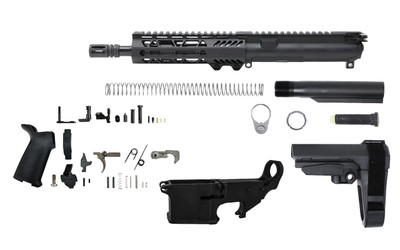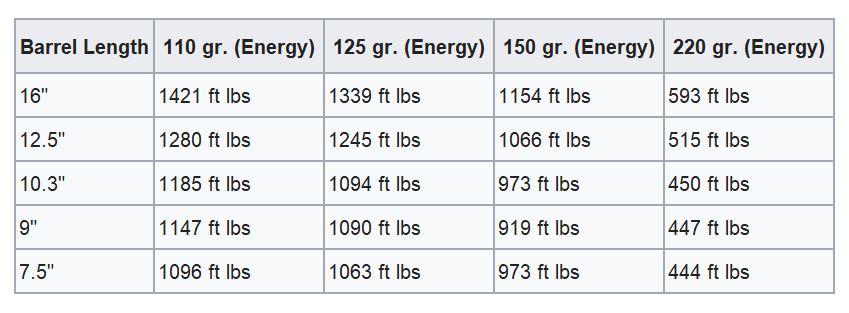The 300 Blackout AR-15 Build Guide
Posted by 80-Lower.com on Aug 31st 2022
300 Blackout is an impressive cartridge: It can be fired suppressed or un-suppressed, subsonic or supersonic, with no modification to the rifle or pistol that's firing it. But to make sure your 300 BLK-chambered AR can shoot both supers and subs with good accuracy and reliable cycling, you've got configure it the right way.
This is your guide to building an AR-15 in 300 AAC Blackout.
Let’s begin.
What is 300 Blackout?
The .300 AAC Blackout (shortened to "300 BLK") is a rifle round developed by Advanced Armament Corp. for the U.S. military’s special operations. It was approved for use in 2011.
Military brass were unhappy with the 5.56's relatively low power and inability to be effectively suppressed due to its supersonic velocity. Spec Ops teams wanted a more powerful .30-caliber round that could be made subsonic for better suppression, while also matching the performance of the Russian 7.62x39mm cartridge.
This new round had to work with existing military rifles, including the M4 and M16, without modification beyond simply swapping barrels and gas systems. The military wanted this cartridge to reuse all other existing components, including the upper and lower receiver, the lower's internals, the bolt and buffer, existing magazines, and handguards.
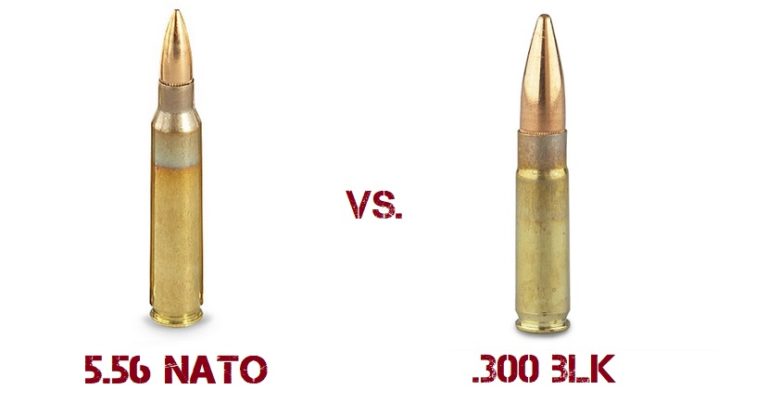
Ammo manufacturer Advanced Armament Corps. (AAC) developed the .300 BLK from their existing .300 Whisper cartridge. The Whisper used a necked down, re-sized 5.56 NATO shell casing with a typical .308 bullet sitting on top.
The Whisper fit in regular AR-15/M4 magazines and still offered a 30-round capacity, thanks to the same shell casing diameter and similar overall length to 5.56. The company submitted this cartridge to SAAMI (the Sporting Arms and Ammunition Manufacturer’s Institution) for testing and approval, and .300 AAC Blackout was officially born.
How to Build a 300 BLK AR-15: The Parts
Building an AR-type rifle, SBR, or pistol chambered in 300 BLK is practically no different than building an AR-15 chambered in 5.56 NATO or .223 Remington. In fact, many shooters convert their existing ARs to 300 BLK from these common cartridges because it usually only requires modifying two things: The barrel and gas system length.
AR-15 parts compatible with .300 BLK and 5.56/.223:
- Lower receiver
- Lower parts kit
- Trigger assembly
- Buffer assembly
- Bolt carrier group
- Upper receiver
- Handguard
- Magazine
These are the only parts that are exclusive to .300 BLK:
- Barrel
- Gas system
Picking a 300 BLK Gas System

The 5.56/.223-chambered AR's gas system can be used with 300 BLK. To reliably cycle subsonic ammo, you will need a pistol-length gas tube. A carbine-, mid- or rifle-length gas tube might not provide enough energy for the bolt to cycle in the upper receiver when firing subsonic loads, causing failures to feeding and eject rounds.
The Best Buffer for 300 BLK Supers and Subs
Virtually all 300 BLK builds use a pistol gas system, and it's what we recommend to use regardless of your choice in ammo. Firing supersonic loads through an AR using a pistol-length gas tube shouldn't result in excessive recoil or wear. To ensure this, you also need the correct buffer weight to handle both supers and subs.
The Winning Buffer is…
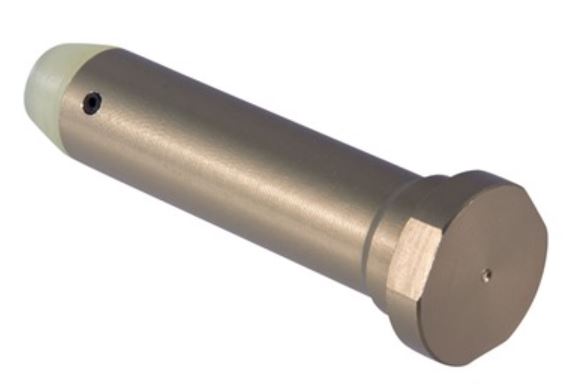
A standard Heavy or "H" buffer. This buffer weighs 3.8 ounces. It uses one tungsten weight and two steel weights. With this buffer, your AR should reliably cycle supersonic and subsonic 300 Blackout ammo without failures to eject or feed. Your bolt should also lock to the rear after the last round is fired.
If an H buffer is too heavy, evidenced by failures to eject or failures to chamber, swap it for a lighter Carbine buffer. This buffer weighs 3.0 ounces and is found in most 5.56/.223 ARs. We recommend trying the "H" buffer first, as it reduces felt recoil. We've found "H" buffers reliably cycle both loads during our own testing.
Barrel Length, Velocity, and Energy
A wide range of barrel lengths work well for building your 300 BLK-chambered rifle or pistol. The twist rate matters most for achieving proper stability and accuracy, but we'll get to that in a moment. Let's take a look at barrel length and performance, first.
300 BLK Barrel Length vs. Velocity
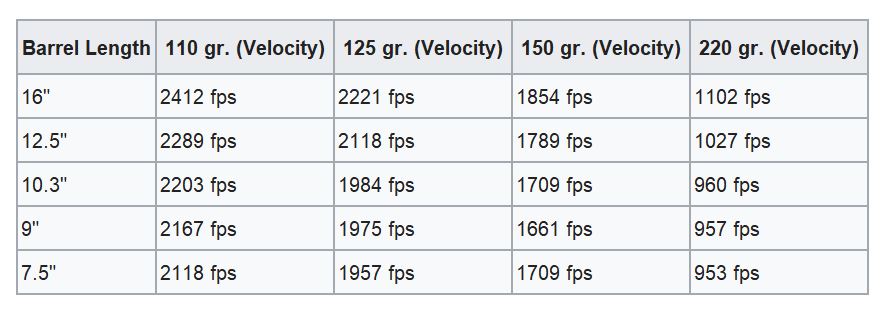
From the data above, we can see the lightest supersonic 300 BLK rounds (110-grain and 125-grain) lose only 12% of their potential velocity as we reduce barrel length from 16" to 7.5". The subsonic load (220-grain) loses approximately 13.5% of its total velocity in the same scenario.
Achieving subsonic velocity with a 16"-barreled rifle.
It's important to note that the 220-grain load's muzzle velocity in a 16" barrel is just barely supersonic, at 1,102 FPS. To achieve subsonic muzzle velocity for adequate suppression with a 16"-barreled build, you'll need to chamber heavier 240-grain loads.
The 12.5" barrel works best for supersonic and subsonic accuracy.
With a 12.5" barrel, your 300 BLK build can retain the most velocity for both supers and subs, without causing heavy loads intended for subsonic use (like 220-grain cartridges) to go supersonic.
300 BLK Barrel Length vs. Muzzle Energy
We find the lightest supersonic load (110-grain) loses 10% of its muzzle energy as barrel length is reduced from 16" to 12.5". Muzzle energy drops a further 16.5%, 19%, and 23% as length is again reduced to 10.3", 9", and 7.5", respectively.
The 10.3" barrel works best for short builds to retain the most subsonic energy.
Reviewing the heaviest subsonic load (220-grain), we find something interesting. As barrel length is reduced from 16" to 12.5", an initial drop in muzzle energy appears at minus 13%. But as we further reduce barrel length to 10.3", 9", and 7.5", we find the loss in muzzle energy plateaus at -25% for all three.
This is why 10.3" barrels are favored most among 300 BLK pistol and SBR builds, and for builds dedicated to shooting suppressed subsonic loads: This barrel length provides the shortest profile and least weight, while retaining the most muzzle energy. This barrel length also helps to keep lighter loads (like 190-grain and 205-grain cartridges) subsonic at the muzzle for adequate suppression, where a longer barrel (like 12.5"+) could cause those loads to go supersonic.
The 9" barrel is the minimum optimal length for shooting longer distances.
A 9" barrel provides the minimum length required to reliably strike targets up 400 meters. U.S. military testing shows that when compared to a 5.56-chambered service rifle, 300 Blackout's 50% hit probability, wind drift, and overall performance is achieved with a 9" barrel at similar distances.
For 5.56 NATO at 14.5", the military says 500 meters is the limit for a 50% hit probability.
5.56 NATO (14.5″ barrel, 62-grain) performance:
- 100″ drop at 500 meters
- 41″ drift at 500 meters
- 291 lb-ft. of energy at 500 meters
- 500 meters max effective range
For 300 Blackout at 9", its max effective range with a 50% hit probability is 440 meters.
300 Blackout (9″ barrel, 125-grain) performance:
- 100″ drop at 410 meters
- 41″ drift at 470 meters
- 291 lb-ft. of energy at 625 meters
- 440 meters max effective range
Although a 9" barrel provides good performance, you've probably seen builders opting for an even shorter barrel, around 7.5". As data shows above, 7.5" is still sufficient for shooting 300 BLK, albeit at closer distances. Sig Sauer built their 300 BLK-chambered MCX "Low Visibility" Carbine (which has seen military service) with a 6" barrel and suppressor.
Optimal Twist Rates
Twist rate matters more than usual with .300 Blackout barrels. That's because twist rate depends entirely on bullet weight. Yet supersonic loads weigh around 80 to 125 grains, and subsonic loads weigh at least 200 grains, often more. Firing both loads accurately -- wherein one weighs twice as much as the other -- means picking the perfect twist rate when it comes to rifling.
A 1:7 or 1:8 twist rate is best for all 300 Blackout loads.
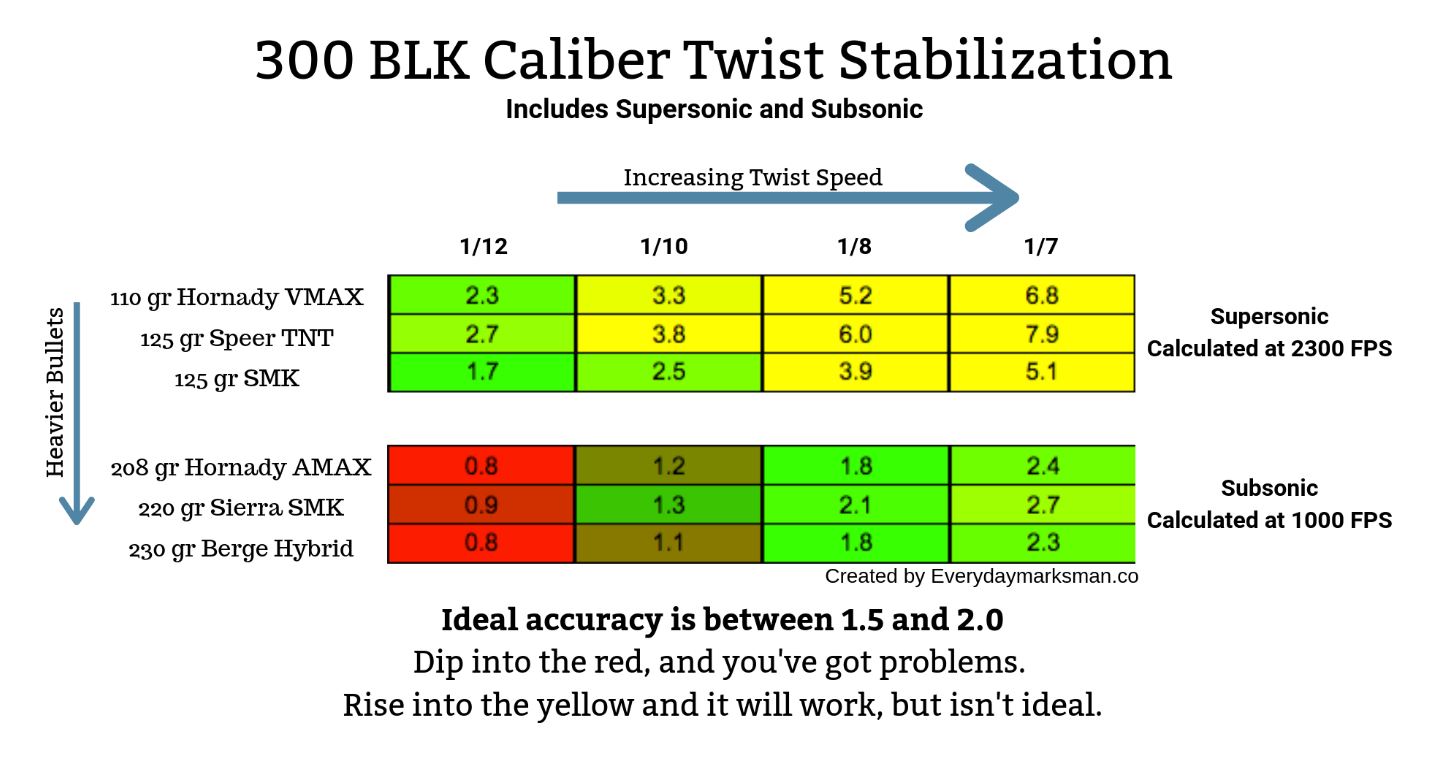
Data and chart courtesy of EverydayMarksman.co
Why? The 1:7 and 1:8 twist rates are optimal for stabilizing subsonic ammo with any barrel length. We can see this in the graph above. Both loads provide stability factors of 1.8 to 2.7, ensuring good accuracy.
Slower rates (like 1:10 or 1:12) may not stabilize subsonic loads -- especially in shorter barrels, as velocity can and likely will dip below 1,000 FPS. This instability would result in those loads tumbling, severely affecting accuracy.
Can't decide between these two rates? Ask yourself this question: Will you shoot lighter supersonic rounds more often? Grab a 1:8 rate to keep stability factors closer to that ideal range.
Will you grab a suppressor and chamber mostly subsonic loads? Grab a 1:7 rate. It'll do a better job at stabilizing those heavy bullets in short barrels, but it can still handle supersonic loads.
Configuring a .300 BLK Pistol

When you do build your 300 Blackout AR, you'll probably purchase a barreled upper assembly that measures less than 16". After all, that's one reason why 300 Blackout was developed: So shooters could enjoy a shorter setup with more firepower. But unless you go through the hoops of legally building your AR-15 as an SBR, you'll need to configure it as a pistol.
DISCLAIMER: If you are new to the world of DIY gun building, you likely have a lot of questions and rightfully so. It’s an area that has a lot of questions that, without the correct answers, could have some serious implications. At GunBuilders.com, we are by no means providing this content on our website to serve as legal advice or legal counsel. We encourage each and every builder to perform their own research around their respective State laws as well as educating themselves on the Federal laws. When performing your own research, please be sure that you are getting your information from a reliable source.

